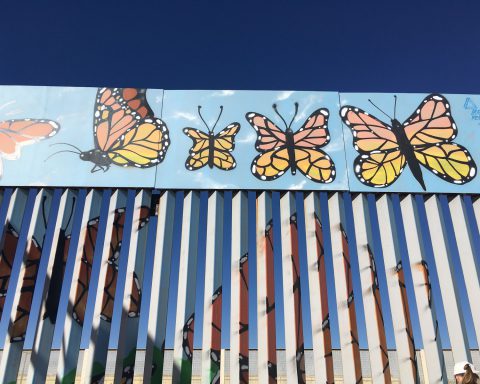You can watch a good movie five times and see a different movie each time. The Sound of Music is one of my favorites for review. I just showed it to my 9-year-old, 7-year-old and 4-year-old grandchildren who were each watching it for the first time. They attend Luria Academy, a Montessori type Jewish school in Brooklyn, and I knew they had heard of the Nazis party. I had an agenda: I wanted them to see a community fighting back.
They loved it! Judah, age 4, now demands a loud “Do Re Mi” at breakfast time. Eva, aged 7, loved the strong girls saying, “They knew how to run fast didn’t they?” Caleb, age 9 and the more cerebral of the bunch, saw the great strategy of the Von Trapps’ one-member defense committee, Max, who kept the music going long enough to get the family off stage in a trickster performance at the music festival.
What was new for this old timer was realizing that this movie is about what we call today “Sanctuary.” The word describes the second sanctuary movement in the US in the last century and is often said with a sneer by the current president. “SAAAAAANctuary cities,” he says, as though there was something wrong with a sacred, safe space. Those of us in the movement know a different word. We have increasing respect for what it means to provide accompaniment – what most of the movement now understands as the second stage of accompaniment or “physical sanctuary.”
Those of us in the movement know a different word. We have increasing respect for what it means to provide accompaniment – what most of the movement now understands as the second stage of accompaniment or “physical sanctuary.”
In New York City, the New Sanctuary Movement has become a coalition and is centered around a large and growing accompaniment program of 200 friends per week being serviced by 3000 alternating, well trained volunteers and another 30 or so physical sanctuaries happening at any given evening. We also count the Jericho walk, our seven-time silent march around Federal Plaza downtown, as a key piece of our provision of sanctuary.
We define sanctuary broadly as moral, legal, material and spiritual support for people being dis-welcomed in this country. We think of the Jericho walk as the spiritual side. We pray quietly all the way around, and then, we end with a primal scream at the federal building. The guards often give us a surreptitious thumbs up as we begin our march on Thursdays.
We define sanctuary broadly as moral, legal, material and spiritual support for people being dis-welcomed in this country.
When we started in NYC twelve years ago, four decisions were critical in the shaping of our movement. First, we decided that we were a religious movement using religious language to protect religious principles — we respect the word sanctuary. Second, we were not working for immigrants but with immigrants. We were ridiculously disciplined about that matter, keeping our numbers on the board, staff and program 50-50 — impacted people and citizens working together for mutual benefit. “We” weren’t helping “them.” These decisions waxed and waned over time, but their general direction more than prevailed. It caused the trust and hospitality to be real, and that is our real product. Third, we wanted to change the system to be about structural justice, but we also had to do the work of mercy. We are embarrassed that we are still so far downstream. We are surely helping hundreds of people from being deported, yet we still experience one farewell after another as deportation continues to happen to our friends.
Our fourth decision about direction had to do with people with priors. Unfortunately, the laws are anti-forgiving. If you have a prior, you can be deported even if you served time or contributed to the economy, the restaurant where you wash dishes or the nursing home where you wash my grandmother. Deportation happens even if you are part of the large group of well-off immigrants who are economic engines par excellence. These laws are anti-forgiveness. They go against religion as well as against immigrants. In this fourth decision, a lot of what we wanted to be as a religious movement came together.
We are definitely in stage two of the sanctuary movement here in NYC. We are in a moment of study and reflection while being surrounded by press who are always looking for the worst case — the most dramatic case. “Can’t you find someone hiding behind a church pillar like in The Sound of Music?” I haven’t been asked exactly that question, but that’s mostly what the press wants. Now, I have realized what the nuns were doing in the movie. Not only do the wonderful reporters who cover the movement act interested in the drama of it all, they want to come and take photographs of someone hiding behind a pillar or sleeping on a church floor. While sanctuary is definitely all about drama, it is rarely as cinematic as the press would like.
So far, what we have learned about our movement is that it is not the work of justice but instead the work of mercy. We failed at comprehensive immigration reform under Obama and are now driven to the daily work of hospitality, not social change. We are not a successful movement or a great movement. Lots of the people we work with get deported. This movement is something more basic like failure and the ability to forgive ourselves for our failures and to adapt, recoup and change. Knocked down nine times, we get up ten. That is greatness. That is resilience — that wild curiosity about failure, trouble, problems, obstacles or plain curiosity about what’s going to happen next to the American experiment. The resilience is the ones we befriend and call friends, the ones who are being dis-welcomed, called names, hunted down and who live with what seems to be a permanent anxiety about home.
The resilience is the ones we befriend and call friends, the ones who are being dis-welcomed, called names, hunted down and who live with what seems to be a permanent anxiety about home.
One of my members grew up during the US supported Khmer Rouge in Cambodia. She immigrated or emigrated. Her mother always told her back “home” that she was eating just rice at 3 a.m., but she knew there was an egg in it. She also knew that her mother had risked a lot to steal that egg. When you work with undocumented immigrants, people we call friends, you realize that it is not the congregations providing sanctuary, physical or otherwise, who are taking risks. It is the mother with the egg. It is the children who forcibly had to leave their homes because they were in such danger there. The Von Trapp family really didn’t want to leave either.
As things become more difficult for us and for immigrants, we are going to need to take more risks. We are going to have to face our failures to protect people, to stop deportations, to allow more detention centers to be built – all of that and more – and wallow also in our success. The New Sanctuary Movement is a great movement. It is also a failure. Having to leave home? What’s fun about that?
As things become more difficult for us and for immigrants, we are going to need to take more risks.
If we US citizens could just face our own priors, maybe we wouldn’t be so accusatory and punitive towards the so-called criminal immigrant. Maybe we’d have a different version of success for movements as well. If we befriend, we are successful. If we lose our sneaky exceptionalism, we are a success.
Ravi Rajbir, our executive director, was in the Orange County Detention system for a brief time because of a so called crime that was white collar and happened nearly two decades ago. Ravi, who has had no crimes since, had a guard in the bathroom with him every time he used the toilet. Ravi is not a danger to the country. He is a gift to the country. He has not been deported; however, one of the other co-founders of the movement, Jean Montrevill, was deported. Both of them and many more are under constant surveillance by the US government. They are like the Von Trapp family who made the mistake of questioning the authority of the government.
Whenever I think of The Sound of Music, I think of our small heroism and all the friends we’ve been able to make. I think of people being helped by churches and religious institutions. I think of sanctuary and am glad my grandchildren got to watch the movie with me.

Rev. Dr. Donna Schaper is one of the co founders of the New York City New Sanctuary movement, the senior minister at Judson Memorial church and associate professor of leadership at Hartford Seminary in the Doctor of Ministry Program.






Unbound Social